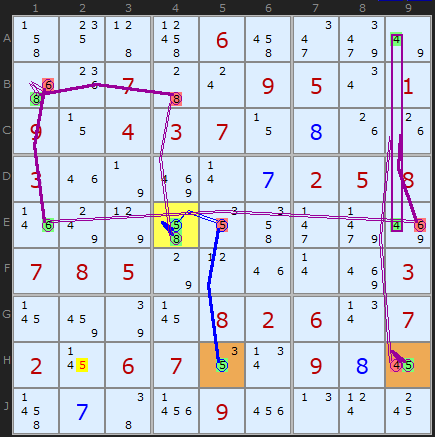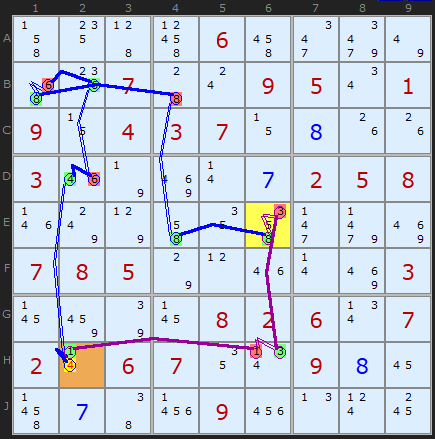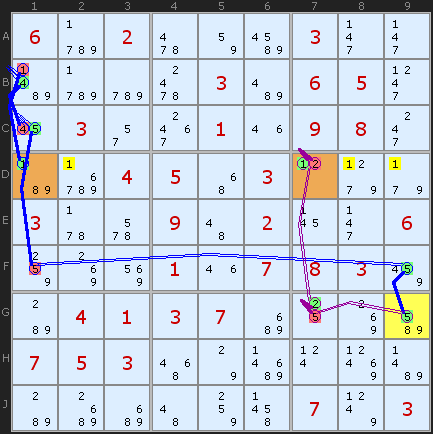| Main Page - Back |
|
From SudokuWiki.org, the puzzle solver's site |

Digit Forcing Chains
This is the start of a family of strategies called Forcing Chains. As the name implies they are made from chains - or formally - Alternating Inference Chains which are simple ON - OFF- ON - OFF consequences. Chains can start with an ON or an OFF. When a candidate X it turned 'on' it immediately turns 'off' all other candidates it can see. When a candidate is in the 'off' state it might turn on another candidate if there is only one left in the unit it can see.
In the strategy Forcing Chains we look at the consequences of a candidate being first ON and then OFF, or a group of candidates in a cell being ON (Cell Forcing Chains) or a number being ON in all instances in a unit (Unit Forcing Chains). If the consequences of the chains are identical - that another candidate is always ON or always OFF - then we have a contradiction.
In the strategy Forcing Chains we look at the consequences of a candidate being first ON and then OFF, or a group of candidates in a cell being ON (Cell Forcing Chains) or a number being ON in all instances in a unit (Unit Forcing Chains). If the consequences of the chains are identical - that another candidate is always ON or always OFF - then we have a contradiction.
If the two ends of the chain meet on the same digit, the we can remove that digit if the ends are OFF, or it's the solution to that cell if the chain ends are both ON.
Likewise, we can attack a whole cell by finding two ON or OFF digits. If OFF, then the last remaining candidate is the solution - but this only works if there are 3 candidates in the whole cell. If ON, then we know that one of those two ON cells is the solution, so any other candidates can be removed.
And finally, the unit attack, based on the same number appearing three or more times in that unit. You will see the pattern now. If we can find two numbers that the chain ends say must be ON, then one of them is the solution and the rest of that number X can be removed from the unit. If there are three numbers left and we identify two numbers that are off, then the last candidate is the solution.
Likewise, we can attack a whole cell by finding two ON or OFF digits. If OFF, then the last remaining candidate is the solution - but this only works if there are 3 candidates in the whole cell. If ON, then we know that one of those two ON cells is the solution, so any other candidates can be removed.
And finally, the unit attack, based on the same number appearing three or more times in that unit. You will see the pattern now. If we can find two numbers that the chain ends say must be ON, then one of them is the solution and the rest of that number X can be removed from the unit. If there are three numbers left and we identify two numbers that are off, then the last candidate is the solution.

The 'digit' in this strategy is a single candidate - in this case the 5 in J9. We are looking at the consequences of this 5 being ON or OFF. Following the blue chain where 5 is OFF we get to the cell E1 where the consequence of 5 being OFF is to turn 6 ON. This chain is (the blue chain):
-5[J9]+5[H9]-5[H5]+5[E5]-5[E4]+8[E4]
-8[B4]+8[B1]-6[B1]+6[E1]
Now, if the 5 in J9 were ON we can trace another shorter chain to E9 were we also find the a 6 can be turned ON. The chain for this is (the purple chain):
+5[J9]-2[J9]+2[C9]-6[C9]+6[E9]
So whether J9 is 5 or not, we know 6 will appear in row E in E1 or E9, so the other 6s in E2 and E8 can be removed.

In the very next step we are obliged to find another Digit Forcing Chain this time centered on 8 in E4. Like the first example it finds that either way the 8 in E2 will give us a 5 either on H5 (the blue chain) or a 5 on H9. This either/or situation establishes 5 in one of those two cells so the remaining 5 in H2 can be removed.
The blue chain is:
-8[E4]+5[E4]-5[E5]+5[H5]
The purple chain +8[E4]-8[B4]+8[B1]-6[B1]+6[E1]
-6[E9]+4{E9|A9}-4[H9]+5[H9] contains an awkward ALS on
{E9|A9} - not easy to spot. The chain goes into the cell E9 and turns OFF the 6 which leaves just a Naked Pair of 4/9 in A9 and H9. That in turn removes the 4 in H9 giving us the second fixed 5 in H9.
Digit to Unit attack

-8[E6]+8[E4]-8[B4]+8[B1]-6[B1]
+6[B2]-6[D2]+4[D2]-4[H2]+1[H2]
The consequence of 8 in E6 being ON also shows that 1 in H2 must be ON as well. The second, purple chain is +8[E6]-3[E6]+3[H6]-1[H6]+1[H2].
So, whether E6 is 8 or not the chains imply H2 must be 1 and that opens up the puzzle to the end game.
Second Example

DIGIT FORCING CHAIN: because of G9, 1s in Row 4 are fixed on [D1,D7]
-5[G9]+5[F9]-5[F1]+5[C1]
-4[C1]+4[B1]-1[B1]+1[D1]
+5[G9]-5[G7]+2[G7]-2[D7]+1[D7]
we can remove 1 from D2
we can remove 1 from D8
we can remove 1 from D9
But it doesn't end there. The very next step uses the new chain link made available by clearing those 1s away. With two 1s on row D we get a new conjugate pair and can extend the longer chain by one more link. This allows us to fix the 2s in column 7, giving us an elimination of 2 in H7.
DIGIT FORCING CHAIN: because of G9, 2s in Col 7 are fixed on [D7,G7]
-5[G9]+5[F9]-5[F1]+5[C1]-4[C1]
+4[B1]-1[B1]+1[D1]-1[D7]+2[D7]
+5[G9]-5[G7]+2[G7]
we can remove 2 from H7